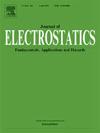颗粒静电电荷水平对金属网过滤器收集效率的影响
IF 2.1
4区 工程技术
Q3 ENGINEERING, ELECTRICAL & ELECTRONIC
引用次数: 0
摘要
过滤介质技术对空气净化的有效性不再是一个有争议的问题。然而,现在的挑战是确定优化颗粒-纤维相互作用的方法,以实现颗粒收集效率和过滤器压降之间的最佳平衡。在本文中,我们对电学性质的相互作用特别感兴趣,这些相互作用主要由库仑、介电泳(DEP)和像力控制。首先,我们制定了一个特殊的实验方案,使我们能够主要关注这些相互作用。然后,通过控制粒子电荷水平,我们能够分离出每种力对收集效率的贡献,并探索影响它们的参数,如电子金属网过滤器(EMMF)中的粒子和电线直径、网格尺寸、网格间距离和电场强度。结果表明,库仑力对收集效率的贡献是最重要的,特别是在强电场和高电荷水平的情况下。电场强度、颗粒直径和纤维直径越小,DEP力效率越高,而网格间距和网格尺寸对DEP力效率的影响有限。像力对收集效率的影响随着粒子电荷的增加而增加,但影响不大。本文章由计算机程序翻译,如有差异,请以英文原文为准。
Effect of particle electrostatic charge level on collection efficiency of an electric metal mesh filter
The effectiveness of filter media technique for air purification is no longer a matter of debate. However, the challenge now is to determine ways of optimizing particle-fiber interactions in order to achieve the optimal balance between particles collection efficiency and pressure drop across the filter. In this paper, we are particularly interested in interactions of an electrical nature, governed essentially by Coulomb, dielectrophoretic (DEP) and image forces. At first, we developed a special experimental protocol that enabled us to focus mainly on these interactions. Then, by controlling particle charge levels, we were able to dissociate the contribution of each force on collection efficiency and to explore parameters influencing them, such as particle and wire diameters, mesh size, inter-grid distance and electric field intensity within an Electric Metal Mesh Filter (EMMF). The results revealed that the contribution of Coulomb force to collection efficiency is the most important, particularly in the case of strong field and high charge level. The efficiency by DEP force increases with field intensity, particle diameter and decreasing fiber diameter, whereas the effect of inter-grid distance and mesh size were limited. As for image force, its impact on collection efficiency increases with particle charge, although it remains marginal.
求助全文
通过发布文献求助,成功后即可免费获取论文全文。
去求助
来源期刊

Journal of Electrostatics
工程技术-工程:电子与电气
CiteScore
4.00
自引率
11.10%
发文量
81
审稿时长
49 days
期刊介绍:
The Journal of Electrostatics is the leading forum for publishing research findings that advance knowledge in the field of electrostatics. We invite submissions in the following areas:
Electrostatic charge separation processes.
Electrostatic manipulation of particles, droplets, and biological cells.
Electrostatically driven or controlled fluid flow.
Electrostatics in the gas phase.
 求助内容:
求助内容: 应助结果提醒方式:
应助结果提醒方式:


